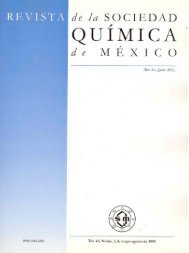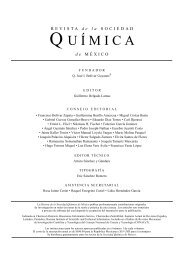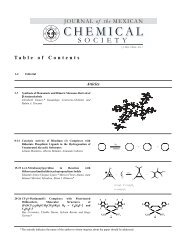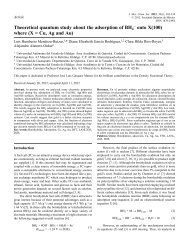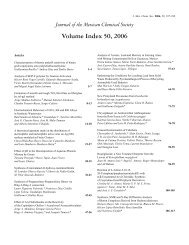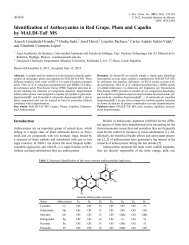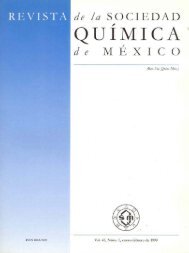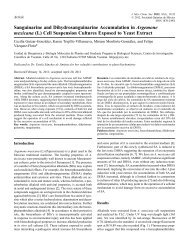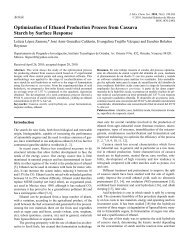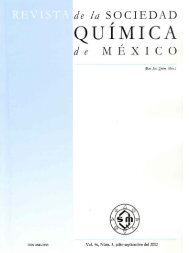SMQ-V047 N-002_ligas_size.pdf - Journal of the Mexican Chemical ...
SMQ-V047 N-002_ligas_size.pdf - Journal of the Mexican Chemical ...
SMQ-V047 N-002_ligas_size.pdf - Journal of the Mexican Chemical ...
Create successful ePaper yourself
Turn your PDF publications into a flip-book with our unique Google optimized e-Paper software.
Revista de la Sociedad Química de México, Vol. 47, Núm. 2 (2003) 105-106<br />
Scientific Contributions <strong>of</strong> Dr. Alfonso Romo de Vivar<br />
Nikolaus H. Fischer<br />
Department <strong>of</strong> Pharmacognosy and Research Institute <strong>of</strong> Pharmaceutical Sciences, School <strong>of</strong> Pharmacy,<br />
University <strong>of</strong> Mississippi, University, MS 38677, USA<br />
I consider it a great honor to be asked to present <strong>the</strong> “Scientific<br />
Laudatio” <strong>of</strong> Dr. Alfonso Romo de Vivar and it is a<br />
pleasant duty to write a summary <strong>of</strong> Dr. Romo de Vivar’s<br />
accomplishments in natural products chemistry. It speaks for<br />
itself, that his scientific contributions span over a time period<br />
<strong>of</strong> nearly one half century. Alfonso can with pride look back<br />
on a highly productive scientific career with impressive<br />
accomplishments and significant contributions to organic<br />
chemistry, in general, and natural products chemistry, in particular.<br />
Alfonso was born in Mexico on April 30, 1928 in San<br />
Francisco de los Romo, Aguascalientes. He received <strong>the</strong> B.Sc.<br />
degree in Chemistry at <strong>the</strong> School <strong>of</strong> Chemistry, Universidad<br />
Nacional Autonoma de Mexico (UNAM) in Mexico City. He<br />
subsequently entered <strong>the</strong> Postgraduate Program in Organic<br />
Chemistry and completed his Ph.D. in 1959. His dissertation<br />
research was directed toward <strong>the</strong> isolation and chemistry <strong>of</strong><br />
sesquiterpene lactones from Helenium mexicanum.<br />
Alfonso spent his whole research career at <strong>the</strong> Institute <strong>of</strong><br />
Chemistry at UNAM, which began in 1958, and in 1992 he<br />
received <strong>the</strong> status <strong>of</strong> Pr<strong>of</strong>essor Emeritus at <strong>the</strong> Institute <strong>of</strong><br />
Chemistry at UNAM. Since 1994 he is also a National Emeritus<br />
Research Scientist <strong>of</strong> <strong>the</strong> National System <strong>of</strong> Scientific<br />
Research. His early research interests were shared with his<br />
mentor, <strong>the</strong> late Pr<strong>of</strong>essor Jesús Romo Armería, <strong>the</strong> “fa<strong>the</strong>r”<br />
<strong>of</strong> <strong>the</strong> Institute <strong>of</strong> Chemistry. Their main focus was on <strong>the</strong><br />
chemistry <strong>of</strong> plant steroids as well as sesquiterpene lactones<br />
from Helenium mexicanum.<br />
It is most impressive that between 1956 and 1961 eight<br />
publications appeared with <strong>the</strong>se two individuals as sole<br />
authors. The papers were published in highly prestigious international<br />
journals including three publications in <strong>the</strong> <strong>Journal</strong> <strong>of</strong><br />
<strong>the</strong> American <strong>Chemical</strong> Society and two in <strong>the</strong> <strong>Journal</strong> <strong>of</strong><br />
Organic Chemistry [1-6].<br />
His increasing interest in sesquiterpene lactones led to a<br />
one-year sabbatical leave (1962-1963) in <strong>the</strong> laboratory <strong>of</strong><br />
Pr<strong>of</strong>essor Werner Herz at Florida State University in Tallahassee,<br />
Florida, USA. This highly productive collaboration<br />
led to a series <strong>of</strong> pioneering studies on <strong>the</strong> structure and chemistry<br />
<strong>of</strong> pseudoguaianolides from <strong>the</strong> genera Helenium and<br />
related taxa. Six papers [7-12] resulted from this collaboration<br />
and appeared in <strong>the</strong> <strong>Journal</strong> <strong>of</strong> <strong>the</strong> American <strong>Chemical</strong> Society<br />
[7], <strong>the</strong> <strong>Journal</strong> <strong>of</strong> Organic Chemistry [10, 11] and Tetrahedron<br />
[8, 9, 12], which again speaks for <strong>the</strong> high productivity<br />
and caliber <strong>of</strong> <strong>the</strong>se publications.<br />
Dr. Romo de Vivar’s teaching career in <strong>the</strong> School <strong>of</strong><br />
Chemistry at UNAM began in 1957. He was <strong>the</strong> mentor <strong>of</strong><br />
about 40 undergraduate students and eleven students received<br />
<strong>the</strong> Ph.D. degree under his direction. Many <strong>of</strong> his publications<br />
on multiple structural types <strong>of</strong> natural products, ranging from<br />
sesquiterpene lactones to diterpenes, to triterpenes, were coauthored<br />
with his dedicated students. Many <strong>of</strong> <strong>the</strong>m have subsequently<br />
developed <strong>the</strong>ir own highly successful, internationally<br />
recognized research programs at UNAM and o<strong>the</strong>r prestigious<br />
academic institutions. O<strong>the</strong>r collaborators include his<br />
colleagues at <strong>the</strong> Institute <strong>of</strong> Chemistry and natural product<br />
chemists from academic institutions in Mexico and o<strong>the</strong>r<br />
countries.<br />
His high productivity in research publications continued<br />
for over three decades [13-16], with a total <strong>of</strong> about150 peerreviewed<br />
papers and reviews being published. He continues to<br />
do research and publish in top international journals on various<br />
aspects <strong>of</strong> natural products chemistry. Since <strong>the</strong> beginning<br />
<strong>of</strong> <strong>the</strong> year 2000 alone, nearly ten papers have appeared<br />
or are in press. This seems to be a good example <strong>of</strong> a chemist,<br />
who “never stops to react”.<br />
Alfonso was <strong>the</strong> recipient <strong>of</strong> a number <strong>of</strong> significant academic<br />
awards for his scientific work. In 1968, he received <strong>the</strong><br />
Science Award <strong>of</strong> <strong>the</strong> <strong>Mexican</strong> Academy <strong>of</strong> Sciences and in<br />
1977 was awarded <strong>the</strong> National Chemistry Award “Andres<br />
Manuel del Rio” by <strong>the</strong> <strong>Mexican</strong> <strong>Chemical</strong> Society. In 1987<br />
he was <strong>the</strong> recipient <strong>of</strong> <strong>the</strong> National University Science<br />
Award, and in 1990, <strong>the</strong> IOCD-Syntex Award by <strong>the</strong> American<br />
<strong>Chemical</strong> Society.<br />
I wish to conclude with a personal note. My first correspondence<br />
with Dr. Romo de Vivar goes back to October 1976.<br />
At that time Alfonso informed me in a short letter, that Dr.<br />
Ronald Hartman had visited and stored our plant collection at<br />
a safe place in <strong>the</strong> Institute. In a handwritten footnote, he<br />
pointed out that a young scientist in <strong>the</strong> Institute, Dr. Leovigildo<br />
Quijano, would send his application for an advertised postdoctoral<br />
position. Leo joined my research group shortly <strong>the</strong>reafter.<br />
This was <strong>the</strong> beginning <strong>of</strong> a life-long scientific collaboration<br />
and close friendship with Leo, that my wife Helga and I<br />
cherish very much. My association and interaction with many<br />
members <strong>of</strong> <strong>the</strong> faculty in <strong>the</strong> Institute <strong>of</strong> Chemistry and <strong>the</strong><br />
School <strong>of</strong> Chemistry continues to this date.<br />
Thank you, Alfonso. You started it all!




